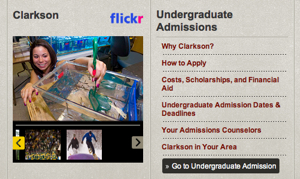Most of us are using social media for communication and were doing it on a shoe string. If you are lucky, you have a social media coordinator on your team. More commonly, the social media role is shoehorned into the job descriptions of several people with other primary responsibilities. While we wait for the number of dedicated positions to catch up with the importance and impact of social media for our campuses, writing a social media strategy should be a priority.
Why? Because strategy will actually help you achieve more with less. So whether you are the only social media evangelist on your campus, or one of several, your strategy should include these elements:
- Purpose: Why do you use social media? Do you use all platforms in the same way to accomplish the same things?
- Values: Is your voice the one that matters most? Is criticism and disagreement allowed in your community?
- Measurement: What statistics and data do you track? What quantitative goals do you have?
- Content: Is it only about you and your brand? Is there a focus on interaction? Is it more than words?
- Engagement: How do you ensure that youll hear from your followers? What will you do to encourage a conversation?
- Policy: Is profanity okay? Do you remove hate language if posted as a comment on one of your channels?
- Oversight: Do you manage departmental and student organization channels centrally? Are there visual standards?
- Brand Management: Does your content support your messaging? Are you reinforcing your reputation through social media?
- Techniques: Do you integrate multiple channels? Do you rotate responsibility for posting content?
With a series of blog posts, Ill tackle each of these elements and offer some suggestions and detail for your evolving social media strategy. Lets start with the letter T: Techniques within your strategy. The three techniques I recommend all revolve around one theme:
Play nice with your website.
Its hard to find an .edu website that does not include social media icons in the footer of every page. (Go try it, Ill wait.) This strategic technique is expected…and not enough. The key is to create an intersection between social media content and your .edu content. Your social media strategy should address the idea that the relationship between your public website and your social channels should be a positive one. No competition and no conflicting messages. (Ooops, were slipping into content and brand management. The many elements of a social media strategy do overlap. More on those two in a later post.)
Here are three techniques that support the intersection between social and .edu content:
- 1. Get endorsement from visitors.
 Include a way for your website visitors to indicate interest in the content on your pages. We explored this technique with the University of Idaho. Using the Facepile plugin you can display the Facebook profile pictures of those who connect with your page.
Include a way for your website visitors to indicate interest in the content on your pages. We explored this technique with the University of Idaho. Using the Facepile plugin you can display the Facebook profile pictures of those who connect with your page. - 2. Bring in a social media feed.
 Give your website visitors proof about what you claim within your content. One technique for showing the goods is to integrate a Flickr feed as a sidebar on high-traffic pages. The Clarkson University Admissions website uses this technique.
Give your website visitors proof about what you claim within your content. One technique for showing the goods is to integrate a Flickr feed as a sidebar on high-traffic pages. The Clarkson University Admissions website uses this technique. - 3. Use mobile to drive traffic to social channels.
 Offer the right content on your mobile site and throw in the fun and and the emotional as a bonus. During orientation, William & Mary’s mobile site offered access to need-to-know student orientation info along with move-in pics from the #wmmovein hashtag stream on Flickr and a YouTube video of the W&M Choir singing the Alma Mater (a must learn for new students).
Offer the right content on your mobile site and throw in the fun and and the emotional as a bonus. During orientation, William & Mary’s mobile site offered access to need-to-know student orientation info along with move-in pics from the #wmmovein hashtag stream on Flickr and a YouTube video of the W&M Choir singing the Alma Mater (a must learn for new students).
Use these two bonus ideas to punch up your list of social media techniques:
- 1. Technique: Experiment with a personal account before stepping into new channels. Back in the day, you could experiment with a new social platform by using an account tied to your institution. The risks to that approach are greater now because social is so widely adopted. We enthusiastically support the technique suggested by University of Wisconsin-Green Bays Todd Sanders, Play with the tool on a personal account before using it on a university account. Thanks, Todd.
- 2. Technique: Build benefits into your channels. If youre doing it right, youre following the advice of Webster Universitys Patrick Powers and your technique is to post awesome content. Read what he has to say: A social network is supposed to be about the people who use it, not the brands pushing products through it. Thanks, Patrick.